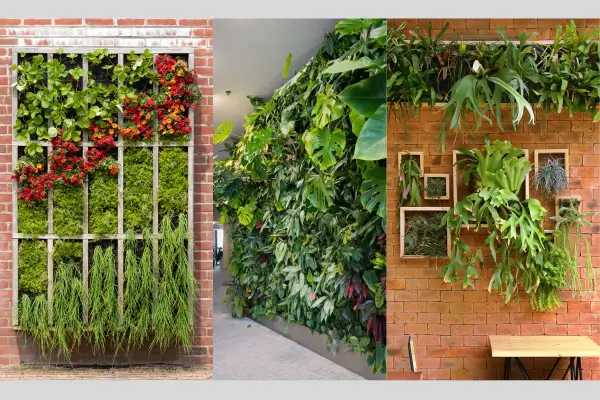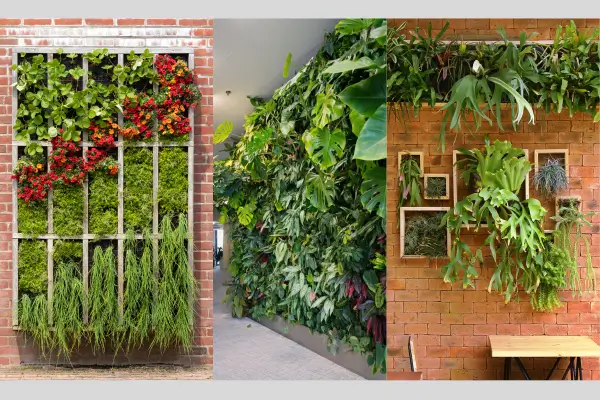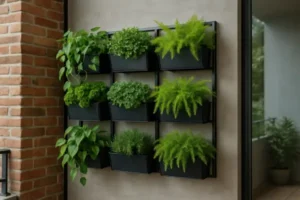Knowing how to install a vertical garden on a rental balcony opens up a simple and stylish way to bring warmth, freshness, and greenery into your living space—even if you’re dealing with rental rules or limited outdoor access.
Even if you have limited space or strict rental rules, there are smart ways to set up a modular vertical garden for gourmet balconies that look beautiful and feel effortless. The secret lies in choosing the right setup, tools, and support structure to avoid leaving marks or drilling holes.
This guide shows how to build a removable vertical garden that fits your space and needs—without damaging walls or breaking lease rules.
How to Install a Vertical Garden on a Rental Balcony: Start with the Right Foundation
Before learning how to install a vertical garden on a rental balcony, it’s essential to think about structure. The challenge is creating a system that’s stable, visually appealing, and easy to remove when you move out.
The good news is, there are several renter-friendly solutions that don’t require altering the property.
A smart first step is choosing a freestanding frame. These are practical because they rest on the ground and rely on their own weight or support—not the walls. Some popular choices include:
- Ladder-style wooden racks: These lean gently against the wall and have wide steps or shelves for placing planters. Ideal for adding height without bulk.
- Leaning plant stands: Often made of metal or bamboo, they provide a sleek, modern look and can support multiple pots in a compact footprint.
- Grid panels with weighted bases: These create a full vertical wall look without installation. You can hang pots or fabric planters directly onto the mesh using S-hooks or zip ties.
These structures can be moved around, adjusted, and styled without leaving any marks. To avoid scratches, place rubber pads or felt buffers where the frame touches the wall or floor.
If your balcony railing allows it, hanging systems with adjustable hooks are another solid option. They attach to the railing, not the wall, and provide a great way to hang baskets or boxes. Just be sure to:
- Choose hooks with silicone covers to protect the railing’s paint
- Test the weight limit of your railing before adding multiple planters
- Use balanced containers to prevent tipping or strain
For narrow balconies, stackable planter units can be a game-changer. These modular pieces are made to lock into place vertically, giving you:
- A clean, vertical look
- Space-saving layers
- The flexibility to remove or rearrange levels anytime
Some even come with built-in water reservoirs and drainage trays—making plant care much easier in tight spots.
Bonus tip: If you’re a DIY fan, repurposing furniture like shoe racks, metal bookshelves, or even old ladders can be an affordable and creative way to build your foundation. Just remember to protect surfaces with liners or waterproof coatings.
Setting the right base is the key to building a vertical garden that feels like part of your home—without leaving a single hole in the wall.
Choose the Right Vertical Garden Structure for Rental Spaces
No two balconies are the same. Some are wide and shallow, others are narrow but tall. That’s why the first step is to take a good look at your space and understand what you’re working with.

Measure carefully, observe how the sun moves throughout the day, and think about how much weight your floor can safely hold.
When renting, you also want to be cautious with anything too heavy or permanently attached. Fortunately, there are plenty of flexible options that let you build a vertical garden without breaking any rules.
Some of the most practical renter-friendly structures include:
- Tension rod systems that extend from floor to ceiling without drilling
- Over-the-railing planters with clamps or hooks that won’t scratch surfaces
- Mobile plant walls on wheels for easy movement and seasonal adjustments
- Repurposed furniture like bookshelves or step ladders that double as plant stands
Each setup works best depending on your routine. If you water your plants daily, a fixed setup might be ideal. If you need to shift things around for better light or weather protection, mobility becomes a big plus.
In the end, the best structure is the one that makes your garden feel like part of your home—easy to care for, easy to love, and just as easy to take with you when it’s time to move out.
Best Materials to Use Without Damaging Balcony Surfaces
Choosing the right materials is just as important as selecting the structure itself. When building a modular vertical garden for gourmet balconies, you need to prioritize items that are lightweight, water-resistant, and easy to maintain—especially if you’re renting and want to avoid costly repairs.
Materials that combine function with care for your space will help extend the life of your setup and prevent wear on walls or floors. A good vertical garden should feel effortless—not something you worry about damaging your balcony over time.
Some of the most reliable options for renters include:
- Recycled plastic or resin planters: These are durable, weather-resistant, and light enough to move around without strain.
- Lightweight metal frames with rubber padding: Metal works well when it’s protected from moisture and has soft contact points to prevent scratching surfaces.
- Vertical garden pockets made of breathable fabric: These are great for herbs and small plants, and they dry quickly after watering.
- Sealed bamboo or treated wood: Offers a warm, natural look and works beautifully when properly coated with a waterproof finish.
On the other hand, it’s best to stay away from materials that tend to cause trouble. Anything that absorbs moisture easily, corrodes with time, or leaves residue should be avoided—especially in small spaces.
To add an extra layer of protection, consider placing a non-slip mat or soft rubber liner underneath the structure. This simple step prevents scuff marks and helps catch water or soil that might drip from your planters.
Keeping these materials in mind not only protects your balcony—it also makes plant care simpler and more enjoyable. And when everything is easy to clean and move, your vertical garden becomes a source of peace instead of a point of stress.
Watering and Drainage: Keep Your Rental Clean and Dry
For larger setups with several rows or deeper containers, understanding how to install a vertical garden on a rental balcony also means thinking about watering systems that work long-term.
A controlled irrigation system can simplify daily care by delivering water directly to each plant through flexible tubes connected to a central reservoir.
These systems use flexible tubes, small connectors, and a central water reservoir, delivering water directly to each plant with minimal effort.
What makes this approach ideal for renters is that it doesn’t require any permanent installation. Most kits are plug-and-play and can be assembled without tools. When it’s time to move, you can simply disconnect the pieces, rinse them off, and take everything with you.
Some benefits of using a controlled irrigation system include:
- Consistent watering: Reduces the risk of overwatering or drying out plants
- Water savings: Delivers moisture directly to the roots, avoiding excess runoff
- Convenience: Great for people with busy routines or frequent travel
- Scalability: You can add or remove lines as your garden grows
If you’re using this system on a rental balcony, keep the reservoir low-profile and opt for a portable water container that blends into the space—like a decorative pot or a narrow storage box. And always check that each connector fits tightly to avoid leaks.
This simple addition can take your vertical garden from a weekend hobby to a low-maintenance daily pleasure.
How to Secure a Vertical Garden Without Screws or Nails
A vertical garden should feel sturdy and dependable, even if it’s not attached to the wall. Since drilling and permanent fixtures are off the table in most rental setups, the goal is to create stability using clever, removable solutions.
Securing your structure becomes even more important if you live in a higher unit or your balcony is exposed to strong breezes. Even slight movement can shift pots or cause your setup to lean over time.
Fortunately, with the right adjustments, you can keep everything in place without making a single hole.
Some renter-friendly ways to add stability include:
- Zip ties or Velcro straps: Use them to anchor the frame to balcony rails, furniture, or other fixed elements. They’re strong, discreet, and easy to remove.
- Planters with locking or interlocking features: These snap into place or stack securely, reducing the risk of sliding or toppling.
- Weighted bases: Adding sandbags, bricks, or hidden weights at the bottom of freestanding frames helps hold everything steady without changing the look.
- Anti-slip pads: Place them under each contact point—especially on tile or concrete floors—to reduce shifting.
If your vertical garden leans against a surface, consider adding foam bumpers or rubber guards along the back. This avoids scuff marks and helps absorb small vibrations from movement or daily activity.
By taking a few extra steps at the beginning, you’ll have a setup that looks great, feels safe, and stays in place—all without putting your security deposit at risk.
Selecting the Best Plants for a Vertical Garden in Small Spaces
With your structure ready, it’s time to bring your garden to life. The plants you choose should fit the space, thrive in containers, and match the amount of light your balcony receives throughout the day.
It’s not just about looks—it’s also about routine. Some plants need daily attention, while others can go a few days without water. If you’re often away or have limited time for care, choose varieties that hold up well with minimal effort.
Here are some excellent options for balcony gardens, depending on your light and lifestyle:
- Herbs: basil, mint, parsley, thyme — great for cooking and easy to grow
- Compact vegetables: cherry tomatoes, lettuce, sweet peppers — ideal for small containers
- Flowering plants: petunias, begonias, pansies — bring color and bloom for weeks
- Low-light choices: pothos, philodendron, ferns — perfect for shaded corners
Try to group your plants by similar care needs. For example, place all sun-loving herbs on the top row where light is strongest, and shade-tolerant plants lower down. This makes watering and pruning faster and more efficient.
Using vertical pockets, wall-mounted trays, or tiered pots will help you keep things organized without crowding the space. And if you’re just starting out, begin with a few easy growers—watch how they respond—then build your garden gradually.
The right plant mix turns even the smallest balcony into a fresh, vibrant corner that lifts your mood every time you step outside.
Maintenance Tips to Keep Your Vertical Garden Looking Fresh
A well-kept vertical garden brings joy every time you step outside. Even in a small space, a few minutes of care each week make all the difference. With the right habits, your plants will stay healthy, vibrant, and manageable—no stress involved.
Think of garden care as part of your regular routine. It doesn’t have to be complicated, especially when everything is organized and within easy reach.
Here are some simple practices that help your garden stay in great shape:
- Water early or late in the day to reduce evaporation and help roots absorb moisture better
- Check soil moisture by touch—if the top inch is dry, it’s time to water
- Remove dead or yellowing leaves to encourage new growth and keep the garden neat
- Clean trays, liners, and planters every couple of weeks to avoid buildup and odors
- Rotate plants occasionally, especially if some areas get more sunlight than others
Consistency is key. Just like taking out the trash or tidying the kitchen, a little attention here and there keeps your garden from turning into a chore. And over time, the process becomes a quiet, rewarding part of your routine—something to enjoy, not just maintain.
Answers to Common Questions About Vertical Gardens in Rentals
Before learning how to install a vertical garden on a rental balcony, it’s normal to have a few practical concerns—especially when you’re working with limited space or renting your home. Here are some of the most frequently asked questions from people in the same situation:
Can I build a vertical garden in an apartment with no balcony?
Yes. You can place a small vertical garden near a bright window using shelves, tiered plant stands, or hanging organizers. As long as you avoid drilling into walls, it’s fully renter-friendly.
Will my landlord allow a vertical garden?
In most cases, yes—especially if the structure is freestanding and leaves no marks or damage. Still, it’s worth checking your lease or sending a quick message to clarify any gray areas.
What plants are best for a shaded balcony?
Snake plant, pothos, spider plant, and calathea are all great choices. They thrive in low to moderate light and are known for being resilient with minimal care.
How do I avoid mold and pests in a vertical garden?
Start with proper airflow and avoid letting moisture sit too long. Choose well-draining soil, water only when needed, and clean your trays regularly. If needed, natural sprays like diluted soap solutions can help keep things in check.
Is it expensive to build a vertical garden?
It doesn’t have to be. You can create a beautiful setup using repurposed materials, secondhand plant stands, or basic containers. The cost only goes up if you choose advanced watering systems or custom-designed kits.
Conclusion
Installing a vertical garden in a rental balcony doesn’t have to be complicated or risky. With the right setup, you can enjoy fresh herbs, colorful blooms, or leafy greens—without altering a single wall or upsetting your landlord.
Start by choosing the structure that suits your space. Keep materials lightweight and easy to manage. Focus on plants that match your routine and lighting. Add a few smart care habits, and your green corner will flourish with very little upkeep.
Whether you’re working with a tiny balcony or a spacious patio, a modular vertical garden for gourmet balconies can transform the area into a calm and lively retreat. It’s your own little oasis in the city, and the best part is: when it’s time to move, your garden can go with you.
Let us know how your garden turns out. And if this article helped you, share it with a friend who’s looking to green up their space without the hassle.




